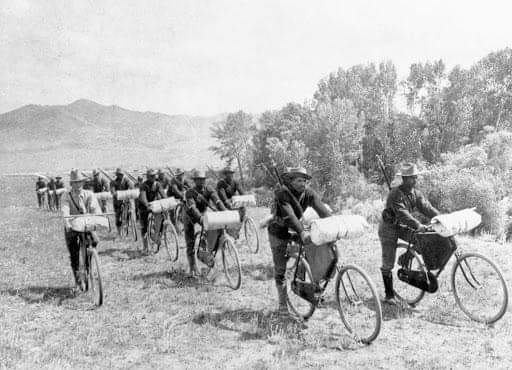1897: African American Buffalo Soldiers test bikes for Army on 1,900 mile expedition
In 1897, 20 soldiers, an army surgeon and a reporter led by Lt. James A. Moss, rode bicycles from Fort Missoula in Montana to St. Louis, Missouri. The trip was made as an experiment to see whether the bicycle could serve a useful purpose in the Army.
1890s America was also experiencing a bicycle-craze due to the recent invention of the "safety bicycle" (a bicycle with wheels of equal size and chain driven). Accounts make it clear that Moss had a romantic streak, and enjoyed the outdoors, as well as what he referred to as "the poetry of cycling".
The 41-day journey to St. Louis was 1,900 miles and took the men through Montana, Wyoming, South Dakota, Nebraska and Missouri. In the 1890s, the Army was segregated, with most black units (a.k.a "Buffalo Soldiers") serving in the isolated outposts in the West. Fort Missoula, at that time, was home to the 25th Infantry, a black regiment. Moss was a Southerner and recent graduate of West Point. He was only twenty-five years old. He and some of the '97 riders had done trips before. In the summer of 1896, eight of them rode first to the Mission Mountains, north of Missoula and then Yellowstone Park. For the St. Louis trip, Moss picked a path that mostly followed the railroads -- the Northern Pacific to Billings and then various arms of the Burlington the rest of the way.
Fortunately, Eddie Boos, a nineteen-year-old, rode along with the Corps to St. Louis and wired lengthy reports to the local Missoula paper, as well as newspapers all over the United States.
Combining his accounts with those of Lt. Moss, we get a fairly detailed picture of the trip. Sadly, no accounts from the soldiers, themselves, are known to exist. We only know them through Boos and Moss's somewhat stereotyped descriptions. Nevertheless, what comes through is a group of highly dedicated, tough, resilient, men who at the end of a long, hard ride still had a keen sense of humor and enjoyment of life*. A year after the trip they proved their mettle as soldiers, securing key victories during the Spanish-American War. Boos tells us that the Corps was escorted by hundreds as they drew closer to the finish of their journey and were welcomed by over 10,000 upon reaching their goal in Forest Park in St. Louis.
In 1897, 20 soldiers, an army surgeon and a reporter led by Lt. James A. Moss, rode bicycles from Fort Missoula in Montana to St. Louis, Missouri. The trip was made as an experiment to see whether the bicycle could serve a useful purpose in the Army.
1890s America was also experiencing a bicycle-craze due to the recent invention of the "safety bicycle" (a bicycle with wheels of equal size and chain driven). Accounts make it clear that Moss had a romantic streak, and enjoyed the outdoors, as well as what he referred to as "the poetry of cycling".
The 41-day journey to St. Louis was 1,900 miles and took the men through Montana, Wyoming, South Dakota, Nebraska and Missouri. In the 1890s, the Army was segregated, with most black units (a.k.a "Buffalo Soldiers") serving in the isolated outposts in the West. Fort Missoula, at that time, was home to the 25th Infantry, a black regiment. Moss was a Southerner and recent graduate of West Point. He was only twenty-five years old. He and some of the '97 riders had done trips before. In the summer of 1896, eight of them rode first to the Mission Mountains, north of Missoula and then Yellowstone Park. For the St. Louis trip, Moss picked a path that mostly followed the railroads -- the Northern Pacific to Billings and then various arms of the Burlington the rest of the way.
Fortunately, Eddie Boos, a nineteen-year-old, rode along with the Corps to St. Louis and wired lengthy reports to the local Missoula paper, as well as newspapers all over the United States.
Combining his accounts with those of Lt. Moss, we get a fairly detailed picture of the trip. Sadly, no accounts from the soldiers, themselves, are known to exist. We only know them through Boos and Moss's somewhat stereotyped descriptions. Nevertheless, what comes through is a group of highly dedicated, tough, resilient, men who at the end of a long, hard ride still had a keen sense of humor and enjoyment of life*. A year after the trip they proved their mettle as soldiers, securing key victories during the Spanish-American War. Boos tells us that the Corps was escorted by hundreds as they drew closer to the finish of their journey and were welcomed by over 10,000 upon reaching their goal in Forest Park in St. Louis.
1897: African American Buffalo Soldiers test bikes for Army on 1,900 mile expedition
In 1897, 20 soldiers, an army surgeon and a reporter led by Lt. James A. Moss, rode bicycles from Fort Missoula in Montana to St. Louis, Missouri. The trip was made as an experiment to see whether the bicycle could serve a useful purpose in the Army.
1890s America was also experiencing a bicycle-craze due to the recent invention of the "safety bicycle" (a bicycle with wheels of equal size and chain driven). Accounts make it clear that Moss had a romantic streak, and enjoyed the outdoors, as well as what he referred to as "the poetry of cycling".
The 41-day journey to St. Louis was 1,900 miles and took the men through Montana, Wyoming, South Dakota, Nebraska and Missouri. In the 1890s, the Army was segregated, with most black units (a.k.a "Buffalo Soldiers") serving in the isolated outposts in the West. Fort Missoula, at that time, was home to the 25th Infantry, a black regiment. Moss was a Southerner and recent graduate of West Point. He was only twenty-five years old. He and some of the '97 riders had done trips before. In the summer of 1896, eight of them rode first to the Mission Mountains, north of Missoula and then Yellowstone Park. For the St. Louis trip, Moss picked a path that mostly followed the railroads -- the Northern Pacific to Billings and then various arms of the Burlington the rest of the way.
Fortunately, Eddie Boos, a nineteen-year-old, rode along with the Corps to St. Louis and wired lengthy reports to the local Missoula paper, as well as newspapers all over the United States.
Combining his accounts with those of Lt. Moss, we get a fairly detailed picture of the trip. Sadly, no accounts from the soldiers, themselves, are known to exist. We only know them through Boos and Moss's somewhat stereotyped descriptions. Nevertheless, what comes through is a group of highly dedicated, tough, resilient, men who at the end of a long, hard ride still had a keen sense of humor and enjoyment of life*. A year after the trip they proved their mettle as soldiers, securing key victories during the Spanish-American War. Boos tells us that the Corps was escorted by hundreds as they drew closer to the finish of their journey and were welcomed by over 10,000 upon reaching their goal in Forest Park in St. Louis.
0 Comments
0 Shares
1174 Views



